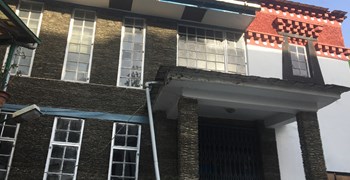History Digitalized for the Future
The mission of the Tibet Museum is to preserve and spread knowledge about the Tibetan culture, history and the situation in Tibet. The museum is run by the Department of Information and International relations (DIIR) in the exile government in Dharamsala since 1998. The museum is now working on digitalizing the wast treasure of around 40,000 photos, so it can be saved and accessable internationally and for future generations.
All who visits the temple of His Holiness the Dalai Lama in McLeod Ganj, Dharamsala, will pass the Tibet Museum inside the temple area. It is a small white stone house with two floors. At the Tibet museum you can learn about the Chinese occupation of Tibet and what has happened during more than fifthy years of oppression. In the upper floor there are film screenings and talks on the Tibet issue and there is also an exhibition on the future visions for Tibet. The museum is well visited by both Indian and Western tourists during high season.
Further down from the town of McLeod Ganj is the museum office and photo archive located in the parliament area of the Tibetan exile government. The archive consists of nearly 40,000 photos. Two years ago it was only a physical archive with paper copies in plastic folders. Because of the moist and hot climate in Dharamsala during the rainy season and cold and dry during the winter, the risk was huge that the photos would have been destroyed by time. Here is invaluable history brought by refugees over the Himalayas from all over Tibet and also collected from settlements in India. Here is also a wast collection of photos from His Holiness the Dalai Lamas activities during the years in exile.
2012 the museum got financial support from an American foundation to digitalize the archive and build a new physical archive.
– Now we have a bigger and better office and a tempered room for the archive with a dehumidifier that helps preserve the physical photos, says Tashi Phuntsok, who is the Director of the Tibet musem since 2012.
Tashi Phuntsok has been working for many years at the museum, before he became Director he was the graphic designer for all exhibitions, books and brochures at the museum.
The latest exhibition is about the self immolations in Tibet.
– We opened the exhibition in April at the beginning of the tourist season when many westerners visits Dharamsala. We want to explain visitors why people in Tibet take drastic actions like self immolations and who they are, those who choose to sacrify their lifes, says Tashi Phuntsok.
– Our exhibitions are in three languages, Tibetan, Hindi and English so that all visitors can understand, says Tashi Phuntsok. Read more at tibetmuseum.org











